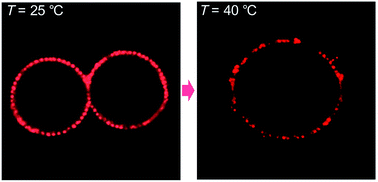On-chip thermo-triggered coalescence of controllable Pickering emulsion droplet pairs†
Abstract
This paper reports on the continuous thermo-triggered one-to-one coalescence of controllable Pickering emulsion droplet pairs in microchannels, with thermo-responsive poly(N-isopropylacrylamide) (PNIPAM) microgels for stabilizing and destabilizing the droplet surface. Oil-in-water (O/W) emulsion droplets with distinct contents are periodically generated in the microfluidic device at temperatures below the volume phase transition temperature (VPTT) of PNIPAM microgels, thus the droplet surfaces are densely packed with hydrophilic and swollen PNIPAM microgels as stabilizers. With increasing the temperature higher than the VPTT, the PNIPAM microgels shrink and aggregate at the O/W interfaces, which expose the initially microgel-covered droplet surface for destabilization. Thus, when flowed into the heated expanded microchamber of the device, every two different droplets are paired and contact with each other for thermo-triggered coalescence, leading to fast mixing of the distinct contents. Such an on-chip thermo-triggered coalescence of controllable droplet pairs is highly attractive for the design and construction of novel droplet-based microsystems as microreactors and microdetectors for various applications such as bio/chemical synthesis, enzyme assays and DNA analysis.


 Please wait while we load your content...
Please wait while we load your content...